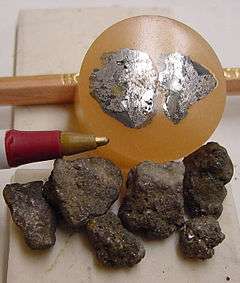Linnaeite
| Linnaeite | |
|---|---|
|
Linnaeite samples and polished section | |
| General | |
| Category |
Sulfide mineral Thiospinel group Spinel structural group |
| Formula (repeating unit) | Co+2Co+32S4 |
| Strunz classification | 2.DA.05 |
| Crystal system | Cubic |
| Crystal class |
Hexoctahedral (m3m) H-M symbol: (4/m 3 2/m) |
| Space group | Fd3m |
| Unit cell | a = 9.43 Å; Z = 8 |
| Identification | |
| Color | Steel gray to gray violet |
| Crystal habit | As octahedral crystals; massive, granular |
| Twinning | On {111} |
| Cleavage | Imperfect on {001} |
| Fracture | Subconchoidal |
| Mohs scale hardness | 4.5-5.5 |
| Luster | Metallic |
| Streak | Grayish-black |
| Diaphaneity | Opaque |
| Specific gravity | 4.8-5.8 |
| Alters to | Tarnishes in air |
| References | [1][2][3] |
Linnaeite is a cobalt sulfide mineral with the composition Co+2Co+32S4. It was discovered in 1845 in Västmanland, Sweden, and was named to honor Carl Linnaeus (1707–1778).[1]
Linnaeite forms a series with polydymite, Ni+2Ni+32S4.[4] Linnaeite is found in hydrothermal veins with other cobalt and nickel sulfides in many localities around the world.[3]
References
- Schumann, Walter (1991). Mineralien aus aller Welt. BLV Bestimmungsbuch (2 ed.). p. 223. ISBN 3-405-14003-X.
This article is issued from Wikipedia - version of the 11/9/2016. The text is available under the Creative Commons Attribution/Share Alike but additional terms may apply for the media files.
